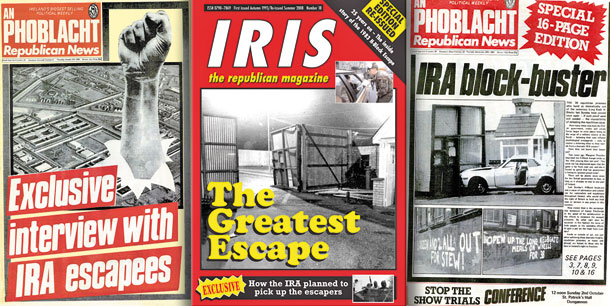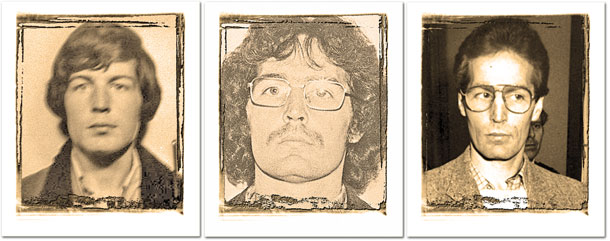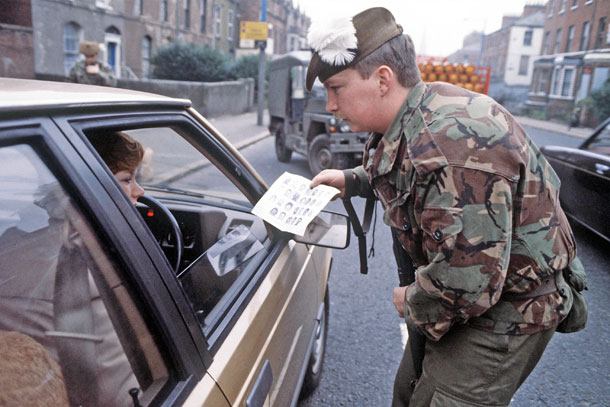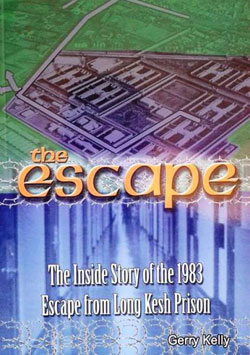1 December 2013 Edition
A history of imprisonment and escape
and ‘The Escape’ The definitive story of a spectacular IRA operation

• Gerry Kelly: "I know it’s a bit of a cliché to talk of ‘the University of Long Kesh’ but it was important for us, as republicans, to develop our politics and learn from the experiences of others involved in anti-colonial struggles"
‘The closest to the truth of the 1983 escape from Long Kesh we’re likely to get’
An Phoblacht, December 2013, Sinn Féin, Bobby Sands, Il Diario di Bobby Sands: Storia di un Ragazzo Irlandese
“AS WITH most escape stories, I wrote the book from the point of view of the political prisoner, of those who took part in one of the most high-profile IRA operations of the conflict.
“There will always be detractors but my experience in writing this book and talking to those POWs involved is that they maintain a great pride in having been part of this historic escapade.
“I share that pride.
“This is my narrative. Others, including the prison guards who served in the North’s prisons, may have their own story to tell but I have set out to set the escape in the context of Britain’s prison strategy and the long conflict we all experienced.”
Kelly was born in the Falls Road area of Belfast in 1953. Like many young people of that time, he became involved in republican politics as a response to the unionist pogroms of 1969.
Reacting to the demands of the Civil Rights Association for equality in voting, employment, housing allocation and education, the unionist government unleashed its state police force in the Royal Ulster Constabulary and its loyalist allies who firebombed hundreds of Catholic homes along the Falls from Dover Street and into the Clonard, where Bombay Street was razed to the ground.
“This brought home to me,” says Gerry Kelly, “that the Orange state, as a Protestant state for a Protestant people, was irreformable at that time. “After internment was imposed in 1971, the British Army paratroopers killed 11 people in Ballymurphy. They were then deployed to Derry where they carried out the slaughter of peaceful civil rights protesters on Bloody Sunday. It became clear to me that there was no alternative but to take up arms.”
On 8 March 1973, IRA Active Service Units planted four bombs in the centre of London. Two of the devices exploded: one outside the Old Bailey and another at Scotland Yard.
“The intent was to bring the message home to the door of the British Establishment,” says Kelly of the attacks in London
“I was one of nine people convicted at Winchester Crown Court on 14 November 1973 and given two life sentences and 20 years. “I was 19 at the time,” he recalls
Seven others from Belfast were convicted too: Dolours and Marian Price, Hugh Feeney, Roy Walsh, Martin Brady, Billy Armstrong and Paul Holmes.
“After we were sentenced,” Kelly says, “we were determined to be repatriated as political status had already been achieved for republicans imprisoned in the North of Ireland.”
Gerry Kelly and others, including the Price sisters and Hugh Feeney, staged a hunger strike demanding to be transferred to prison in the North. Refusing food, he was force-fed 167 times in the course of a 205-day hunger strike.
“Pretty horrific stuff,” he recounts. Every time he was aggressively pinned down by several prison warders as his mouth was prised opened and a tube roughly shoved down his throat. Then a type of gruel was poured into him.
“We were later joined on hunger strike by IRA Volunteers Michael Gaughan and Frank Stagg from Mayo, both of whom died later in English prisons,” he recalls, pausing in memory of them.
In April 1975, Kelly and Feeney were transferred to the Cages of Long Kesh while Dolours and Marian Price were moved to Armagh women’s prison alongside those republican women POWs with political status.
In the Cages, Kelly read a lot.
“I know it’s a bit of a cliché to talk of ‘the University of Long Kesh’ but it was important for us, as republicans, to develop our politics and learn from the experiences of others involved in anti-colonial struggles. I was still very focused on escaping, though.” He laughs: “I wanted back onto the streets and into the struggle again.”
It was after attempting to escape in 1982 with Peter ‘Skeet’ Hamilton, ‘Big Ned’ Maguire and Francis ‘Flakey’ McIlvenna that Kelly had his political status removed. He was transferred to the H-Blocks and ended up playing a central role in the 1983 escape.

The Great Escape had a huge impact on Gerry Kelly.
“One of the strangest things for me after the escape was the way in which I came across people from all political walks of life throughout the country — Fine Gael people, Fianna Fáil and Labour people — who were willing to help us. Houses and homes were opened up to us by people who did not see themselves as republicans but who understood why we were fighting.”
Gerry’s journey from Long Kesh to south Armagh and then on to the relative safety of Leitrim is part of legend, especially the weeks he and seven other escapees spent hiding under floorboards in the County Armagh town of Lurgan.
“We couldn’t move from the day we arrived, the day of the escape, until the day we were smuggled across the Border. It was unbelievable what the people of the house endured to protect us.”
Many of those who got away went to ground before reporting back to the IRA for active service.
Gerry Kelly disappeared until 16 January 1986, when he was captured in the Netherlands along with Brendan ‘Bik’ McFarlane in Amsterdam.
At the time of their arrest, cash in several currencies, maps and fake passports and the keys to a storage container holding 14 rifles, 100,000 rounds of ammunition and nitrobenzene for explosives were recovered by the Dutch Police.
On 4 December that year, the pair were extradited from the Netherlands into British custody. And the struggle continued.

• Early 1970s, Early 1980s and captured in the Netherlands in 1986
GERRY KELLY was imprisoned for the first time in Dublin in August 1971 and jailed for two years. Within five months he had escaped from Mountjoy Prison.
He returned North and went on the run.
He was captured a second time in England in the aftermath of the Old Bailey bombings. While in England, in Wormwood Scrubs Prison he made an unsuccessful bid for freedom.
Back in Ireland, having been repatriated after his hunger strike, he made another escape attempt, this time from Lagan Valley Hospital, where he had been taken for medical treatment.
Five years later, in 1982, he and three comrades were thwarted as they made their way to the perimeter of Long Kesh having evaded the security at their Cage.
Sent to the H-Blocks, Kelly was central to the success of ‘The Great Escape’, rocking the British political establishment to its core.
Dateline: 25 September 1983: 38 IRA prisoners smash their way out of the maximum-security H-Blocks of Long Kesh, considered one of the most escape-proof prisons in Europe
‘The Escape’ The definitive story of a spectacular IRA operation
AT the official launch of his book, Gerry Kelly told his audience in Cultúrlann Mac Adaim Ó Fiaich that “this is the closest to the truth of the 1983 escape from Long Kesh that we are likely to get”.
Having read the book it is clear that – for reasons of legality and security – what he said is true.
He could have added that while some things cannot be said, the reality is that the authenticity of Kelly’s writing means that this is the definitive story of what must be one of the most spectacular IRA operations of the conflict. “Unprecedented detail,” says veteran Ireland commentator David McKittrick.
From the initial ideas for the break-out right through to the meeting of the IRA Army Council when the full escape plan got the green light and the nuts and bolts planning of the massive back-up operation by IRA Volunteers from the South Armagh Brigade, what we see is a co-ordinated military assault on the British Establishment that had far-reaching political ramifications.

• The British Army mounts a checkpoint in Belfast searching for escapees following the break-out
Kelly’s account of that period is set firmly in a post-Hunger Strike Long Kesh still locked in the highly-charged atmosphere of five years of a brutal ‘Blanket Protest’, two hunger strikes and ten republican POWs dying in a struggle with an unyielding and brutal regime.
The H-Blocks still reeked of the viciousness of the prison regime, the callousness of the Thatcher Government and the arrogance of prison officers who beat, starved and degraded republican Blanketmen for years.
So as the authorities basked in their ‘victory’ with the ending of the 1981 Hunger Strike, the IRA was plotting the next phase of the struggle in the jails.
On 25 September 1983, 38 IRA prisoners burst out of Long Kesh maximum-security prison, considered to be one of the most escape-proof prisons in Europe.
The political and military ramifications of the ‘Great Escape’ cut to the heart of the British political establishment.
 British Prime Minister Margaret Thatcher’s visit to Canada
was overshadowed by the news. ‘The Iron Lady’ was most unhappy at the
international media spotlight being on the political conflict in the North of
Ireland once again. “It is the gravest [breakout] in our present history, and
there must be a very deep inquiry,” she told reporters through gritted teeth.
British Prime Minister Margaret Thatcher’s visit to Canada
was overshadowed by the news. ‘The Iron Lady’ was most unhappy at the
international media spotlight being on the political conflict in the North of
Ireland once again. “It is the gravest [breakout] in our present history, and
there must be a very deep inquiry,” she told reporters through gritted teeth.
Kelly’s book recounts the meticulous planning and highlights both the ingenuity of the POWs and the very personal stories of those involved.
Through the pages, you feel the tension and the surge of adrenalin as the plan is put into action. The stakes were high not only for those going on the escape but those who were left behind — the rearguard.
Gerry Kelly focuses on the part played by the rearguard, those who held H-Block 7 until the very last minute to give their 38 comrades the best possible chance of getting away. These were men with very little of their sentences left to serve and the repercussions for them were immeasurable.
Another aspect of the story is the way in which the prison officers arrested by the POWs as they seized key locations in the escape plan were treated. None was gratuitously ill-treated despite the fact that among their number were some of those who had inflicted vindictive beatings on Blanketmen during the protest years.
Towards the end of the book, the author remembers those who were part of the operation who have since died.
Some of these returned to active service and lost their lives in IRA operations while others died of natural causes.
It is a reminder to us all that the story of our struggle is first and foremost a struggle of ordinary people who accomplished extraordinary things in extraordinary times.
• The Escape, by Gerry Kelly. Price £12.50 or €14.99. Available from the Sinn Féin Art Shop, 53 Falls Road, Belfast; and the Sinn Féin Bookshop, 58 Parnell Square, Dublin.




